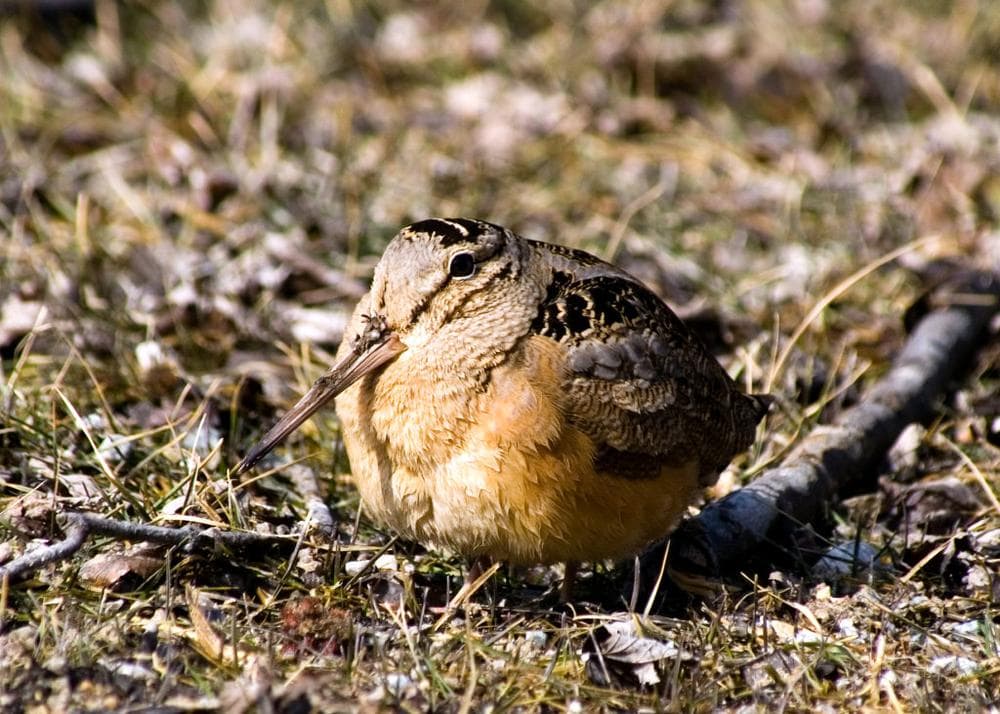Advertisement
Looking For Birds? Check Out Wacky Woodcocks

It's hard to get into birding in this day and age because it's basically the antithesis of on-demand entertainment. Setting out on a birding expedition, guides can hardly promise you'll actually see anything.
Joy Marzolf, however, can come pretty close at the Mass. Audubon Society's Broadmoor Wildlife Sanctuary in Natick, especially while running the society's Wacky Woodcocks program.
She's so confident not because the sanctuary is haven for all sorts of critters, which it is, but because the American Woodcock's mating ritual is the Old Faithful of eccentric wildlife behavior. And Broadmoor Wildlife Sanctuary is home to a large population of the birds.
Avian Flirting
The woodcock's mating ritual happens every spring evening from April to June, a few minutes past dusk, and often in the same spot. The Old Faithful geyser analogy also applies in another way, as Marzolf explained.
"They basically soar up, skyrocket up, and do a sort of twisty turny flight right down," Marzolf said.
To put this behavior in context, you have to consider the demeanor of the male woodcock. Search for him on YouTube and you'll see videos of this lumpy little brown cannonball on stilts with a preposterously long beak and an absurd gait.
This is the animal that performs what early environmentalist Aldo Leopold called the "sky dance." Just after the sun sets, the woodcock picks a spot out in the open where he can be easily seen in the fading light. When he's sure he has an audience, he blasts upward in an explosive spiral. He hangs in the air for an instant, then dive-bombs back to earth.
Advertisement
"They can go up several hundred feet actually," Marzolf said. "They're not doing a two- or three-foot fall."
And what's the purpose of this dive-bombing dance?
"Oh, it's all about impressing the girls," Marzolf laughs.
Creeping through shrubs, we kept our eyes open for a flirtatious bird. We were surrounded by the chirps of woodcocks, though they competed with the spring peepers and a distant commuter train on the Worcester Line.
Marzolf, with her practiced eye, suddenly spotted our target. The fat little bird blasted off. His wings supposedly made a "flip, flip, flip" sound, though, I couldn't hear it.
"He's going to come down about that same spot, so look for him in this area," Marzolf told us.
Shhhhwwoooooom, back down he zigzagged, like a feather falling on fast forward. It was amazing.
"Meep, meep," said the bird. Basically, it translates to "Eh? Eh? You see that? Check it out, I'm gonna do it again!"
We watched as this particular fellow leaped and dove a few more times before, presumably, getting lucky. We decided to give him and his mate a little privacy and head back in.
The American Woodcock
The mating dance is still very common, but it's getting a little harder to come by because the American Woodcock hasn't been doing so well in recent years, especially here. New England forests have been on the rebound, and that's been bad for woodcocks, which like shrub land.
The birds are nowhere near endangered yet, but still, it might be increasingly hard to catch this crazy display while the season lasts. If you want something close to a sure thing, the Mass. Audubon Society runs its Wacky Woodcocks program one final time Friday at 7:30 at Broadmoore Wildlife Sanctuary in Natick.
This segment aired on April 27, 2011.